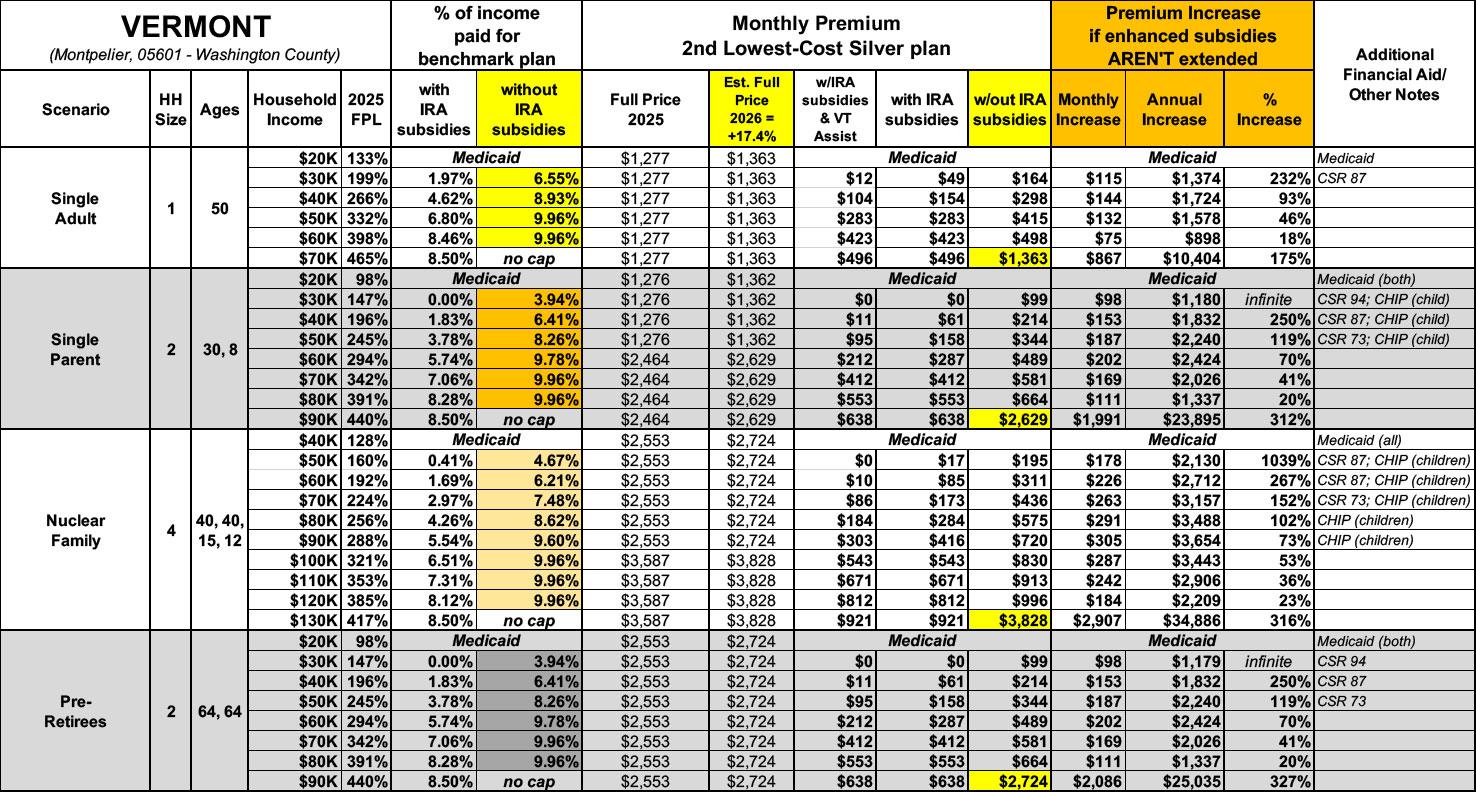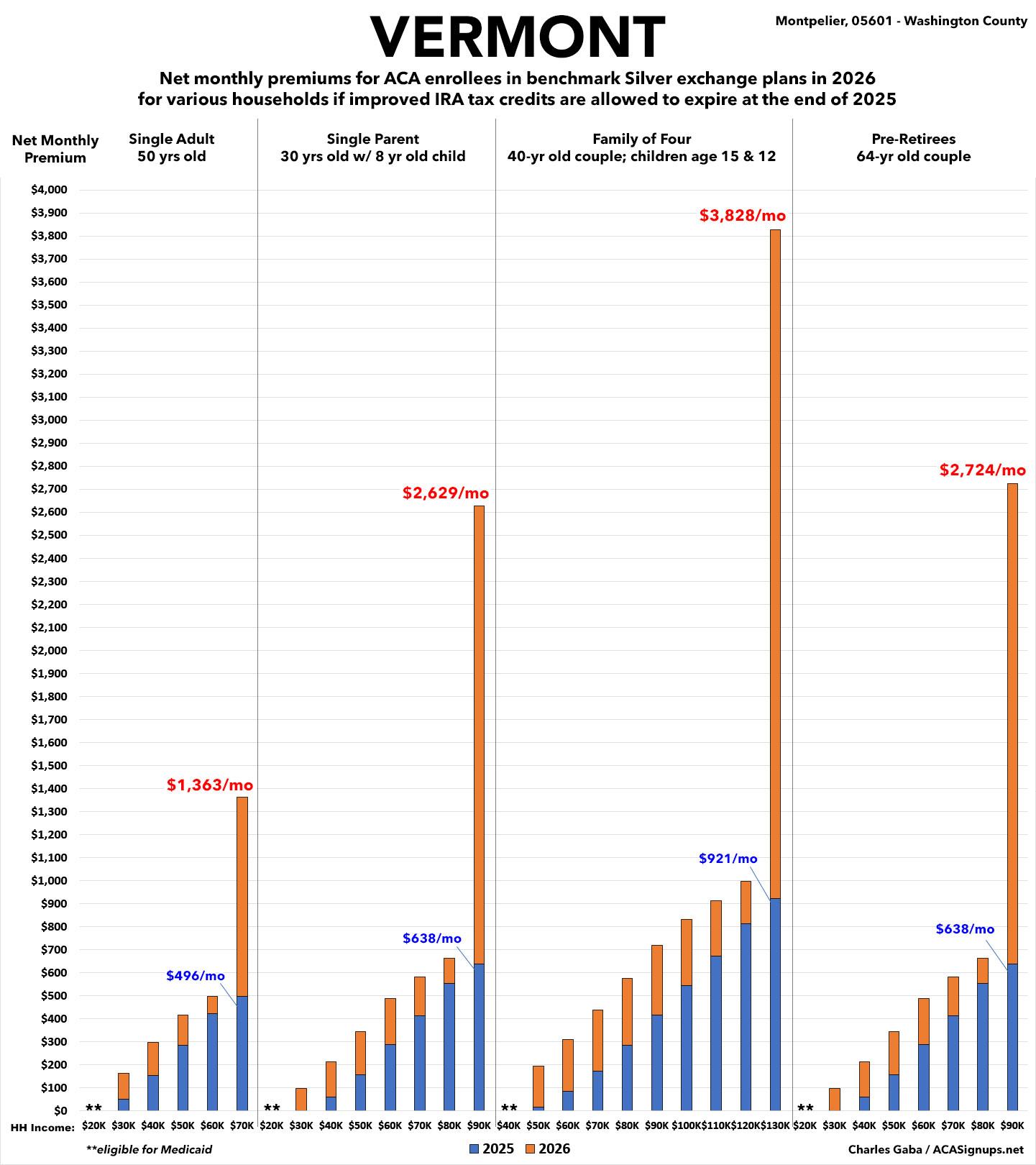How much more will ~36,000 VERMONT residents pay if the improved #ACA subsidies expire? (updated)

Originally posted 1/30/25
Vermont has around ~32,000 residents enrolled in ACA exchange plans, 93% of whom are currently subsidized. I estimate they also have another ~2,000 unsubsidized off-exchange enrollees.
Combined, that's ~35,000 people, although the official carrier rate filings claim it's more like 36,000 statewide.
In early 2021, Congressional Democrats & President Biden passed the American Rescue Plan Act (ARPA), which dramatically expanded & enhanced the original premium subsidy formula of the Affordable Care Act, finally bringing the financial aid sliding income scale up to the level it should have been in the first place over a decade earlier. They then extended the subsidy upgrade out by another 3 years via the Inflation Reduction Act.
In addition to beefing up the subsidies along the entire 100 - 400% Federal Poverty Level (FPL) income scale, the upgrade eliminated the much-maligned "Subsidy Cliff" at 400% FPL, wherein a household earning even $1 more than that had all premium subsidies cut off immediately, requiring middle-class families to pay full price for individual market health insurance policies.
Unfortunately, the improved subsidies are currently scheduled to end effective December 31, 2025. Needless to say, with Republicans holding a trifecta, it's highly unlikely that the IRA's enhanced subsidies are going to be be extended further. They had the opportunity to do so as part of H.R. 1 (the so-called “Big Beautiful Bill”), but chose not to.
It gets worse:
In addition, the so-called “Affordability & Integrity Rule” put into place by RFK Jr., & Dr. Oz at the Centers for Medicare & Medicaid Services (CMS) is causing 2026 subsidies to be even less generous and gross premiums to increase even more.
In Vermont specifically, the 2 insurance carriers initially asked for gross premium increases averaging 17.4%, but state regulators chopped this down to a (relatively low) 6.7%.
I decided to run the numbers myself to get an idea of just how much the combination of expiring IRA subsidies and the CMS "Affordability/Integrity Rule" will cause net premiums to increase starting in January 2026.
I'm using four household scenarios, at several different income levels for each:
- a 50-yr old single adult earning between $20K - $70K/year
- a 30-yr old single parent w/an 8-yr old child, earning between $20K - $90K/year
- a 40-yr old couple w/2 children age 15 & 12, earning between $40K - $130K/year
- a 64-yr old couple earning between $20K - $90K/year
There's several caveats:
-
The average Benchmark Silver ACA premiums are based on 2026 levels.
-
Benchmark Silver premiums vary widely depending on where you live & other factors.
-
In some states, children under 19 are eligible for CHIP or Children's Medicaid at a significantly higher household income level. This can cause a sudden jump in full-price premiums as the household income moves over that eligibility threshold.
-
These analyses assume that the enrollees choose the benchmark Silver plan, and that the benchmark plan remains the same both years (the actual benchmark plan often changes from one year to the next).
-
NEW: The original version of this analysis included a 4.3% increase in the unsubsidized benchmark plan premium based on a projection by the Congressional Budget Office. However, that was a national average projection which didn’t take into account other factors like increased utilization, medical inflation and so on. This updated version assumes the actual 2026 rate filings.
-
NEW: The original version of this analysis assumed that the Applicable Percentage Table would revert back to the pre-2021 levels. However, the Trump Administration recently modified the formula used to calculate this which means that ACA subsidies will be even less generous starting in 2026.
Note that unlike most states, Vermont has no age band, which means the official full-price premium for all enrollees is the same for each plan regardless of their age. In addition, like a few other states, Vermont has their own state-based supplemental subsidy program on top of the federal subsidies; I'm not sure how this will impact net premiums next year.
With all that understood, let's take a look:
-
A single 50-yr old earning $30,000/yr would go from paying $12 in premiums to between $105 - $142/month...up to 11x as much.
-
A single parent earning $40,000/year would go from paying $11/month to between $135 - $185/month...up to 16x as much.
-
A family of four earning $60,000/year would see their premiums jump from $10/month to between $195 - $270/month...up to 27x as much.
-
A 64-yr old couple earning $90,000/yr would go from paying $638/mo to $2,724/mo...Over FOUR TIMES as much as they're paying today for the same policy.
There’s still a chance that Congressional Republicans might agree to extend the improved subsidies when they reconvene next month, but:
- The odds of it happening are slim;
- They would likely only agree to a watered-down version and/or would include poison pill demands of Democrats in return;
- Even if they do so, the actual rate hikes will likely already be baked in for 2026 (which would still leave unsubsidized enrollees stuck with the gross rate hikes), and…
- even if they do, some of the Trump Admin’s other regulatory changes would still leave ACA enrollees with higher costs (including raising the cap on out of pocket expenses by $900/yr more than it would be otherwise).







